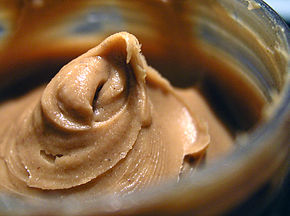Peanut butter: Difference between revisions
Grimfandango (talk | contribs) m Previous URL was redirected. Updated to correct page. |
2 words |
||
| Line 45: | Line 45: | ||
* [http://a257.g.akamaitech.net/7/257/2422/14mar20010800/edocket.access.gpo.gov/cfr_2002/aprqtr/21cfr164.150.htm The federal "Peanut Butter Law" in the U.S.] |
* [http://a257.g.akamaitech.net/7/257/2422/14mar20010800/edocket.access.gpo.gov/cfr_2002/aprqtr/21cfr164.150.htm The federal "Peanut Butter Law" in the U.S.] |
||
* [http://www.ams.usda.gov/AMSv1.0/getfile?dDocName=STELPRD3481951 The USDA's Commercial Item Description for peanut butter and peanut spread (PDF)] (Last accessed 3 September 2008) |
* [http://www.ams.usda.gov/AMSv1.0/getfile?dDocName=STELPRD3481951 The USDA's Commercial Item Description for peanut butter and peanut spread (PDF)] (Last accessed 3 September 2008) |
||
Hi Zach! |
|||
[[Category:American cuisine]] |
[[Category:American cuisine]] |
||
[[Category:Peanuts]] |
[[Category:Peanuts]] |
||
Revision as of 17:20, 6 January 2009

Peanut butter is a food paste made primarily from ground roasted peanuts, with or without added oil. It is popular throughout the world and is also manufactured in some emerging markets. Its primary use is as a sandwich spread.[citation needed]
Similar peanut pastes are popular in various cultures. In South Indian cooking, chili peppers are added to make a spicy variant of peanut paste. In Andhra Pradesh, India, peanut chutney is popular. In this variation, peanuts are ground and mixed with chili peppers and other ingredients.
In some types of gourmet peanut butter, chocolate or other ingredients may be added. Various nut butters are also made from other nuts.
History
Peanuts, which are native to the New World tropics, were mashed into paste by Aztecs hundreds of years ago.[citation needed]
Evidence of modern peanut butter comes from US patent #306727 issued to Marcellus Gilmore Edson of Montreal, Quebec in 1884, for a process of milling roasted peanuts between heated surfaces until the peanuts reached "a fluid or semi-fluid state." As the product cooled, it set into what Edson described as "a consistency like that of butter, lard, or ointment."
In 1890, George A. Bayles Jr., owner of a food business in St. Louis, manufactured peanut butter and sold it from barrels.
J.H. Kellogg, of cereal fame, secured US patent #580787 in 1897 for his "Process of Preparing Nutmeal," which produced a "pasty adhesive substance" that Kellogg called "nut-butter."
Health
Health benefits
Peanut butter may protect against a high risk of cardiovascular disease due to high levels of monounsaturated fats and resveratrol; butter prepared with the skin of the peanuts has a greater level of resveratrol and other health-aiding agents.[1] Peanut butter (and peanuts) provide protein, vitamins B3 and E, magnesium, folate, dietary fiber, arginine,[2] and high levels of the antioxidant p-coumaric acid.
Plumpy'nut is a peanut butter based food used to fight malnutrition in famine stricken countries. A single pack contains 500 calories, can be stored unrefrigerated for 2 years, and requires no cooking or preparation.[3]
In the novel Make Room! Make Room! by Harry Harrison, and the film Soylent Green, based on the novel, an impoverished and malnourished world is portrayed; the government supplies a peanut butter ration to prevent "the kwash" (kwashiorkor, associated with protein deficiency) in children.
Health concerns
For people with a peanut allergy, peanut butter can cause reactions including anaphylactic shock which has led to its banning in some schools.[4]
The peanut plant is susceptible to the mold Aspergillus flavus which produces a carcinogenic substance called aflatoxin.[5] Since it is impossible to completely remove every instance of aflatoxins, contamination of peanuts and peanut butter is monitored in many countries to ensure safe levels of this carcinogen. Average American peanut butter contains about 13 parts per billion of aflatoxins, a thousand times below the maximum recommended safe level.[citation needed]
Some brands of peanut butter may contain a large amount of added hydrogenated vegetable oils, which are high in trans fatty acids, thought to be a cause of atherosclerosis, coronary heart disease, and stroke; these oils are added to make the butter easier to spread. Natural peanut butter, and peanuts, do not contain partially hydrogenated oils. A USDA survey of commercial peanut butters in the US did not show the presence of trans fat.[6]
Also, at least one study has found that peanut oil caused relatively heavy clogging of arteries. Robert Wissler, of the University of Chicago, reported that diets high in peanut oil, when combined with cholesterol intake, clogged the arteries of Rhesus monkeys more than did butterfat. [Atherosclerosis 20: 303, 1974]
Other uses
A common, simple outdoor bird feeder can be made by coating a pine cone once with peanut butter, then again with birdseed.[7]
Peanut butter is an effective bait for mouse traps.[8]
References
- ^ Sci Tech The Hindu, December 14, 2006
- ^ WH Foods
- ^ Michael Wines (2005-08-08). "Hope for Hungry Children, Arriving in a Foil Packet". The New York Times.
- ^ James Barron (September 27, 1998). "Dear Mr. Carver. This Is a Cease and Desist Order". New York Times.
{{cite news}}: Check date values in:|date=(help) - ^ "Aflatoxins in Your Food - and their Effect on Your Health". Environment, Health and Safety Online.
- ^ Peanut butter is trans fat free.
- ^ "Pine Cone Bird Feeder". Wisconsin State Environmental Education for Kids!.
- ^ "Victor brand rodent control solutions web site".
External links
- The National Peanut Board
- The federal "Peanut Butter Law" in the U.S.
- The USDA's Commercial Item Description for peanut butter and peanut spread (PDF) (Last accessed 3 September 2008)
Hi Zach!
